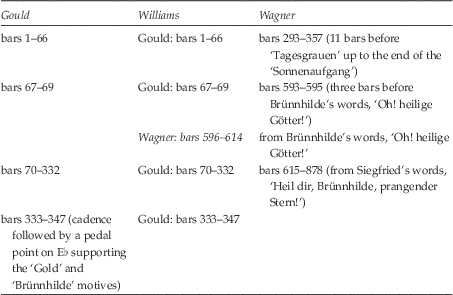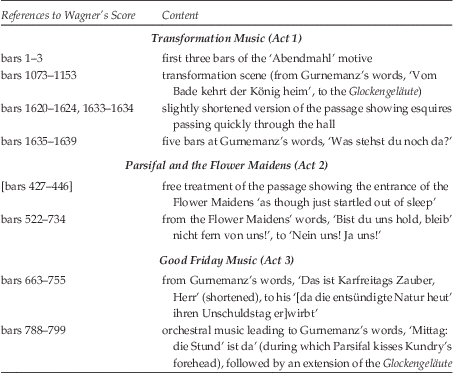Few music lovers are likely to be familiar with Wagner’s piano music. My first and only contact up to this point occurred some 40 years ago, when I listened to a two-record set by the German pianist Martin Galling (b. 1935), released in 1963 on the budget label Turnabout.Footnote 1 I did not feel compelled in any way to renew the experience in the near future, if ever. Despite having been a passionate Wagnerian since my teenage years, I am very likely to wait at least another 40 years, if at all possible, before renewing the experience of listening to his piano music, especially in such a massive and concentrated dose as was required for the present purposes.
Except for one in 1840, Wagner composed all of his short works for piano between 1853 and 1875. They may please some listeners, despite their very limited and unoriginal keyboard writing. However, the bulk of Wagner’s piano output (in terms of number of pages) was produced in 1831 and 1832, when the composer was at most 19 years old. It consists of two overly long sonatas (totalling 32 and 27 minutes, respectively) and a fantasia (lasting 29 minutes). There seems to be an unwritten law in the fields of art and music by which a canonical master can do no wrong, leading devotees to look for some (any!) redeeming value in a work bearing the creator’s prestigious signature. But despite Wagner’s hand, these works are of very slim interest; written six years before the composition of Rienzi, they sound amateurish. Fortunately, Wagner was gifted with other talents, and his immense genius would later give life to many operatic masterpieces.
Nevertheless, neither recording under consideration in this review should escape the attention of Wagnerians. The earliest one, released in 2013 by Brilliant Classics, features the Italian pianist Pier Paolo Vincenzi (b. 1980), who teaches piano in municipal schools in Orvieto and Scandicci and chamber music at the Accademia Musicale (Florence). For Brilliant Classics, he recorded the variations on Diabelli’s waltz by all 51 composers (released in 2015), and, for Meridian, he has begun a series devoted to recording all of Weber’s sonatas. He is joined for a four-hand piece by Federica Ferrato (b. 1979), who, in addition to performing and teaching, has published on piano-related topics. The second release features the Welsh pianist Llŷr Williams (b. 1976), who, in his ‘Artist’s Note’, tells us that he discovered Wagner at age ten, when he received Georg Solti’s Ring as a Christmas present (just like me, but I was 16). In addition to liner notes by Daniel Jaffé, the CD booklet reproduces an appraisal by Sir Curtis Price (then Principal of the Royal Academy of Music), who recalls that Williams, when auditioning for the répétiteur course, claimed to be able to reproduce any part of the Ring at the piano. Price suggested the beginning of the second act of Siegfried, and Williams played the music and sang the vocal parts from memory. He is now one of the regular accompanists at the BBC Cardiff Singer of the World Competition. For Signum, he previously recorded two disks that include Mussorgsky’s Pictures at an Exhibition and excerpts from the second year of Liszt’s Années de pèlerinage, among others works.
Vincenzi’s set is a complete traversal of Wagner’s extant works for the piano, going even beyond the contents of vol. 19 of the Sämtliche Werke published by Schott, also available in a practical edition (without critical report).Footnote 2 The additional pieces, likely to be included in the still unpublished twenty-first volume (consisting of supplements), are (1) the version for piano solo (WWV 23a) of a Polonaise in D major for four hands;Footnote 3 (2) an alternative version for the third movement of the Grosse Sonate in A major (WWV 26), which includes a fugue (39 bars) inserted between the Maestoso and the Allegro molto;Footnote 4 (3) a 19-bar Notenbrief für Mathilde Wesendonck from the annotations to Tristan und Isolde;Footnote 5 (4) a 13-bar Elegy in A flat (1859), catalogued under WWV 93 as ‘[Thema] in As-Dur (fälschlich Porazzi-Thema genannt)’;Footnote 6 and (4) an 82-bar Schluss zum Vorspiel from Tristan und Isolde, attached to a letter of 19 December 1859 to Mathilde Wesendonck.Footnote 7 The Notenbrief and the Elegy last less than two minutes; the Schluss zum Vorspiel is more substantial at 4:30.
Williams’s set includes six original works by Wagner: the long Fantasy of 1832 plus five short pieces, all recorded earlier by Galling, Vincenzi and others. Interspersed throughout the discs are six of Franz Liszt’s 15 superb operatic transcriptions, composed between 1848 and 1882. These are now well known to listeners thanks to several more or less complete recordings released in the past 40 years, after the stigma against arrangements as valid musical works had started to loosen its grip.Footnote 8 The major point of interest of this set is the inclusion of two of the three Wagner transcriptions by the Canadian pianist Glenn Gould (1932–1982), with revisions by Williams, and of the latter’s own transcription of three scenes from Parsifal.
Gould recorded his Wagner transcriptions in 1973 on a disc entitled A Pianistic Tour de Force: Glenn Gould Plays His Own Transcriptions of Wagner Orchestral Showpieces.Footnote 9 At the time of their release, these transcriptions were noted for their use of overdubbing, making it possible (in ‘Siegfried’s Journey to the Rhine’ and the Prelude to Meistersinger) to include notes that would otherwise have to be left out. How Gould achieved his result remained a mystery until his arrangements of both pieces (in addition to Siegfried Idyll) were published by Schott in an edition by Carl Morey, now retired from the Faculty of Music at the University of Toronto.Footnote 10 In his liner notes, Williams writes that he has ‘taken the liberty of re-allocating some of the material between the two pianos in order to give an even more faithful account of what is going on’. He also interpolates the final section of the passionate duo between Siegfried and Brünnhilde that leads into the former’s Rhine journey.
This review is a good opportunity to show exactly how Gould’s transcription of the excerpt from Götterdämmerung and Williams’s insertion are laid out with respect to Wagner’s music.Footnote 11 Gould’s overdubbing is found in bars 175–241 and 272–297 of his score in the form of a supplementary staff (see Table 1). For Meistersinger the technique is used in bars 128–222 (out of a total of 223 bars): a single staff for bars 128–259 and 205–214, and two for bars 160–202 and 215–222.
Table 1 Gould’s and Williams’s transcriptions, as they relate to each other and to Wagner’s Götterdämmerung.

The transcription of Parsifal, which Williams was persuaded to write by his producer Judy Sherman, consists of three attacca tracks for a total duration of 21 minutes. (See Table 2 for a synopsis.) In all but a few passages, the music is more or less similar to the piano part of Karl Klindworth’s vocal score, with a few added runs and incorporation of material from the vocal parts when needed to fill out the texture. A notable departure is the dynamic climax of the transformation music, when Wagner reaches a C![]() -minor chord with an ascending scale in the violins (at bar 1123). Here Williams provides a much fuller texture, with some additional changes of register.
-minor chord with an ascending scale in the violins (at bar 1123). Here Williams provides a much fuller texture, with some additional changes of register.
Table 2 Williams’s transcription, drawn from Wagner’s Parsifal

Pier Paolo Vincenzi offers very competent and clean performances on a Fazioli F278 piano. He signs his liner notes, which could have been more complete with more bibliographical information on the rarer works, as listed above. He is courageous enough to make all the repeats in the already overlong works of Wagner’s ‘immaturity’. Williams’s performances are very solid and clear throughout, with expert voicings and delineation of parts. The Liszt transcriptions – from Rienzi, Der fliegende Holländer (‘Spinning Chorus’), Tannhäuser (‘Entry of the Guests’), Lohengrin (‘Elsa’s Bridal Procession’), Das Rheingold (‘Walhall’) and Tristan und Isolde (‘Liebestod’) – are all superbly handled. A slightly faster climax in the ‘Liebestod’ might have led to a more effective rendition. Williams’s interpretations show that these (mainly) orchestral passages from Wagner’s operas sound very well on the piano despite being so idiomatic to the orchestra. In closing, it may be appropriate to mention a recent recording of Wagner’s two sonatas (WWV 21 and 26) by Tobias Koch on a disk containing the Seven Compositions on Goethe’s ‘Faust’ (WWV 15), on Classic Produktion Osnabrück CPO 3506395, released in 2013. There may be more interest yet in these youthful works!




